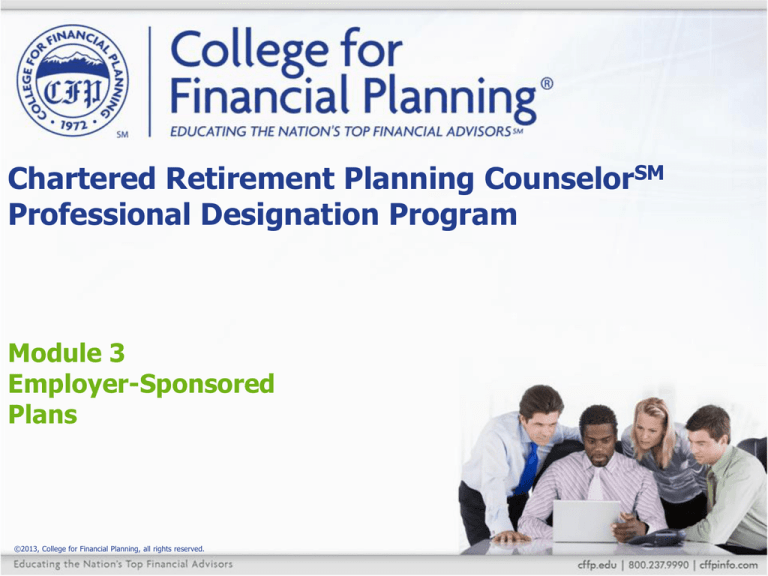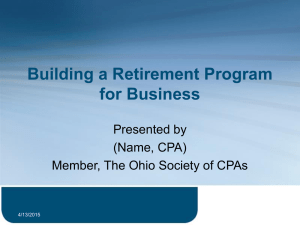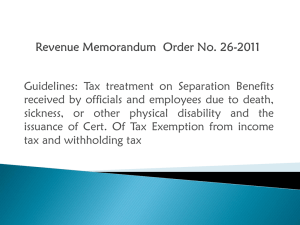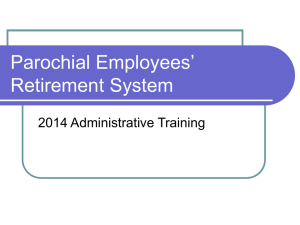
Chartered Retirement Planning CounselorSM
Professional Designation Program
Module 3
Employer-Sponsored
Plans
©2013, College for Financial Planning, all rights reserved.
Learning Objectives
3–1: Describe basic characteristics of qualified retirement plans
and the main types of qualified plans.
3–2: Describe basic characteristics of profit sharing and money
purchase plans.
3–3: Describe basic characteristics of 401(k) plans.
3–4: Describe basic characteristics of Keogh plans.
3–5: Explain basic characteristics of defined benefit plans.
3–6: Describe basic characteristics of retirement plans that are
designed for small employers.
3–7: Describe basic provisions of retirement plans that are
designed for nonprofit entities.
3-2
Questions to Get Us Warmed Up
3-3
Learning Objectives
3–1: Describe basic characteristics of qualified retirement plans
and the main types of qualified plans.
3–2: Describe basic characteristics of profit sharing and money
purchase plans.
3–3: Describe basic characteristics of 401(k) plans.
3–4: Describe basic characteristics of Keogh plans.
3–5: Explain basic characteristics of defined benefit plans.
3–6: Describe basic characteristics of retirement plans that are
designed for small employers.
3–7: Describe basic provisions of retirement plans that are
designed for nonprofit entities.
3-4
Factors Affecting Qualified Plan Contributions & Benefits (plan level issues)
Contributions to Plan During Employment Years
• (deduction limits) Retirement Benefit
Defined Contribution Plan
Up to 25% of covered payroll for all
defined contribution plans.
Benefit determined by:
• contributions—based on plan formula,
allocated according to relative compensation
and/or years of service
• investment returns—allocated according to
relative account balance
• forfeiture reallocations—allocated according
to relative compensation and/or service time
Defined Benefit Plan
Contribution determined annually by
actuary, to fund benefit of up to the
lesser of $205,000 in 2013 or 100% of
compensation—affected by investment
performance, forfeitures, personnel
assumptions
Specific benefit up to the lesser of $205,000 in
2013 or 100% of compensation, defined as flat
amount or percentage of compensation; plan
may credit years of service
3-5
Diversification & Investment Requirements
IRC Section 401(a)(28)
ERISA Section 204(j) requires most defined contribution plans
maintained by publicly traded corporations to permit participants
to direct that the following percentages of employer securities
held in their accounts be reinvested in suitable alternative
investments:
• 100% of amounts attributable to 401(k) elective deferrals
• For participants with at least 3 years of service: 33% of
amounts attributable to employer contributions for the first
year; 66% of amounts attributable to employer contributions
for the second year; and 100% of amounts attributable to
employer contributions for the third year
3-6
Diversification & Investment Requirements
IRC Section 401(a)(28)
ESOPs maintained by either publicly traded or privately
owned companies that are funded with employer contributions
only (“stand-alone” ESOPs) must permit a participant age 55 or
older with at least 10 years of participation to diversify the
following percentages of employer securities held in his account
into other assets over six consecutive plan years:
• 25% of account balance over the first five plan years, and
• 50% of his account balance in the sixth and last plan year.
• Stand-alone ESOPs are not subject to ERISA 204(j)
3-7
Participant Level Issues
IRC Section 415(c) Limit on “Annual Additions”
to an Individual Participant’s Account in a
Defined Contribution Plan
Annual Additions
Employer contributions +
Employee contributions +
Forfeiture reallocations
Limited to lesser of
100% of compensation or
$51,000
3-8
Selected Characteristics of SEPs & Defined Contribution Plans
Basic Characteristics
Simplified
Employee
Pension Plan
(SEP)*
Employer Contribution:
Maximum Deduction
Mandatory?
Employee Contribution
Forfeitures
Annual Additions Limit
Nondiscrimination
Profit
Sharing
Plan
Stock
Bonus
Plan or
ESOP
Money
Purchase
Plan
Target
Benefit
Plan
25% of covered payroll
No; fully
discretionary
No, but must be
substantial and
recurring
401(k) / CODA provisions may be
permitted
N/A
Reallocated
Yes; % of
compensation or flat
sum, as stated in plan
Yes; per plan
formula
401(k)/CODA not
permitted, but after
tax contributions
allowed
After tax
contributions
allowed
Reallocated or reduce employer
contribution
The lesser of 100% of individual’s compensation or $51,000
Coverage and participation tests
*Although not considered a qualified plan because it consists of participants’ IRAs, a SEP is subject to many defined contribution plan
requirements.
3-9
Learning Objectives
3–1: Describe basic characteristics of qualified retirement plans
and the main types of qualified plans.
3–2: Describe basic characteristics of profit sharing and money
purchase plans.
3–3: Describe basic characteristics of 401(k) plans.
3–4: Describe basic characteristics of Keogh plans.
3–5: Explain basic characteristics of defined benefit plans.
3–6: Describe basic characteristics of retirement plans that are
designed for small employers.
3–7: Describe basic provisions of retirement plans that are
designed for nonprofit entities.
3-10
Profit Sharing Plans
Basic Provisions
• 25% employer deduction limit.
• Employer contributions usually are discretionary, but must be
“substantial and recurring.”
• Forfeitures usually are reallocated to remaining participants’
accounts.
Advantages
Disadvantages
No fixed annual contribution required
may motivate employees if based on
profits.
Plan may benefit younger participants
when the goal is to benefit older
owner.
Younger participants benefit from
many years of tax-deferred
Participant
contributions, compounding earnings,
and forfeiture reallocations
Employer is not required to contribute
annually.
Employer
3-11
Stock Bonus Plans
Basic Provisions
• Same provisions as profit sharing plans, except
contribution is in employer stock
Advantages
Employer
Cashless contributions aid cash flow
Participant
Allows participants to share in company ownership.
Tax is deferred on appreciated stock until sale (“net
unrealized appreciation”). May direct investment of
assets invested in employer securities into other
suitable investments.
Disadvantages
Voting rights must be passed on to participants.
Employees who meet certain requirements have the
right to direct that assets invested in employer
securities be reinvested in other suitable
investments.
3-12
Leveraged Stock Ownership Plan
Basic Provisions
•
•
•
Primary purpose of ESOP is to invest in qualifying employer securities
Contributions of up to 25% of payroll may be used to buy securities for plan
Diversification requirements for ESOPs: participants age 55 or over with at least 10
years of service must be offered election to transfer up to 25% of account to
alternative investments—election period covers six years, with 50% transfer
available in year 6
Advantages
Employer
Cashless contributions aid cash flow. Leverage used
to buy employer stock. Deductions on loan to
purchase stock: 25% for loan principal repayment,
unlimited interest expense for C corporations.
Interest is part of 25% contribution limit for S
corporations.
Participant
Allows participants to share in company ownership.
Tax is deferred on appreciated stock until sale.
Diversification rights apply to component plans.
Disadvantages
Plan cannot be integrated with Social Security.
Participant can elect distribution in cash at fair
market value.
3-13
Money Purchase Plan
Basic Provisions
•
•
Employer contributions of up to 25% of covered payroll
•
•
Subject to minimum funding standard
Forfeitures may be reallocated to remaining participants’ accounts or
applied to reduce employer contributions
Money purchase plans are no longer useful with 25% profit sharing plans
available
Advantages
Disadvantages
Employer
Young owners and employees benefit from years of
tax-deferred contributions, earnings, and
compounding. Larger deduction allowed than for
profit sharing plan
Forfeitures applied to reduce employer contribution
will impact cash flow and tax planning. Fixed
mandatory annual contributions
(minimum funding standard)
Participant
May benefit from forfeiture reallocations if so
applied.
3-14
Target Benefit Plans
Provisions Shared with
Defined Contribution Plans
• Maximum annual additions to
a participant’s account are
limited to the lesser of 100%
of compensation or $51,000
• Retirement benefit is
determined by account
balance
• Employee assumes
investment risk
• No annual actuarial
determination
• Forfeitures may be reallocated
or used to reduce employer
contribution
Provisions Shared with
Defined Benefit Plans
• Plan generally benefits older
employees
• Actuary determines initial
contribution level and formula
for allocating contributions
• Mandatory annual
contributions
3-15
Target Benefit Plans
Basic Provisions
•
•
•
Employer contributions of up to 25% of covered payroll
•
Subject to minimum funding standard
Allocation of employer contributions based on age-weighted formula
Forfeitures may be reallocated to remaining participants’ accounts or
applied to reduce employer contributions
Advantages
Employer
Participant
Disadvantages
Relatively simple to explain and install. Annual
contributions generally in favor of older, highly
paid participants.
Mandatory annual contributions. Limits
employer’s tax deduction
Younger participants could benefit from years of
contributions and compounding. Participants
benefit from excess earnings.
Participants assume investment risk.
Note: The target plan is no longer a useful plan.
The age-weighted profit sharing plan can
provide all its benefits without the fixed annual
contribution obligation.
3-16
Learning Objectives
3–1: Describe basic characteristics of qualified retirement plans
and the main types of qualified plans.
3–2: Describe basic characteristics of profit sharing and money
purchase plans.
3–3: Describe basic characteristics of 401(k) plans.
3–4: Describe basic characteristics of Keogh plans.
3–5: Explain basic characteristics of defined benefit plans.
3–6: Describe basic characteristics of retirement plans that are
designed for small employers.
3–7: Describe basic provisions of retirement plans that are
designed for nonprofit entities.
3-17
401(k) Provisions
•
Section 401(k) plan must be combined with a qualified defined
contribution plan (profit sharing, stock bonus, pre-ERISA money
purchase), a SARSEP (if SARSEP is established prior to 1997), or a SIMPLE
•
25% limit on total of employer contribution excluding salary reduction or
CODA contribution
•
•
Employee is always 100% vested in own contributions
Nondiscrimination requirements: ADP and ACP tests
Plans Authorized Under IRC §401(k)
Salary Reduction,
401(k) Plans (CODAs)
Salary Reduction, 401(k) Plans
•
•
Employee elects to defer income (or
bonus) and taxation on a portion of
compensation before it is paid or
earned
Deferral is subject to FICA and FUTA
•
•
Employee elects to receive employer’s
contribution either in cash (currently
taxable) or as a tax-deferred retirement
plan contribution
Employee contributions are subject to
FICA and FUTA
3-18
401(k) Plans Employee & Employer Eligibility
•
•
•
Employee eligibility requirements – one year of service (generally
1,000 hours) and age 21
Employer eligibility to establish 401(k) plans
o Sole proprietors
o Partnerships
o C and S corporations
o Tax-exempt organizations
o Indian tribal governments
Under current law, state
and local governments
are prohibited from establishing 401(k) plans
3-19
401(k) Plans Pre-tax Participant Contributions
• Are called “elective deferrals” or “salary reduction
•
•
•
•
contributions” (tax-deferred but are subject to payroll
taxes; i.e., FICA and FUTA).
2013 limit = $ 17,500, or $23,000 if age 50 or over
Affirmative election—salary reduction agreement
Negative elections—employees
are automatically enrolled
unless they elect out
Catch-up contributions
($5,500 for 2013)
3-20
401(k) Usage & Investment Responsibility
• Studies indicate 401(k) plans are:
•
•
•
o underutilized by employees
o but the vast majority of employees contribute
something to their 401(k) plans
o most plan participants lack the knowledge to make
good investment choices
401(k) plan fiduciary duties include establishing a
funding policy suitable for the participants
401(k) plans do not have to permit participant-directed
investments—but many plans allow this
A plan fiduciary is potentially liable for losses if a
substandard directed investment option is selected
3-21
401(k) Provisions
Advantages
Motivates employees if contributions are
based on profits.
Employer
Participant
Employer’s tax deduction (deduction is
based on covered payroll and is not
affected by deferrals). Employer
contributions do not have to be made out
of profits
CODA allows participants options on
contributions
Disadvantages
Employer qualified matching and qualified
nonelective contributions vest 100% to
participant (of course elective deferrals are
always 100% vested)
ADP and ACP nondiscrimination tests
Withdrawals of elective deferrals available
before age 59½ only under hardship
3-22
Basic Characteristics of Plans with 401(k)/ Salary Reduction Provisions
Profit Sharing or
Stock Bonus Plan with 401(k)
Characteristic
SARSEP
Employee
Contribution
$17,500 in 2013 (indexed) maximum elective deferral plus
$5,500 age 50 catch-up if eligible
Employee Matching
Contribution Available?
No
Yes
Forfeitures
N/A; no forfeitures
Reallocated (employer contributions)
In-Service
Withdrawals
Distributions at any time,
subject to 10% penalty if
premature
Under hardship conditions,
employee’s elective contributions can
be withdrawn (subject to 10%
penalty if premature)
Tax Treatment of
Distribution
Ordinary income tax on
distribution amount
Forward averaging may be available
Nondiscrimination Tests
Coverage and special ADP
test
Coverage, ADP, and ACP tests
Loan Provisions
Not allowed
Per plan provisions; five-year
repayment
3-23
Keogh Plans
Basic Provisions
•
•
May be established by sole proprietor or partnership
Takes the form of a qualified plan (defined contribution or defined benefit),
but certain provisions for owner/employee are unique to Keoghs:
owner/employee’s contribution is calculated on earned income
plan loans to common law employee-participants and
owner/employee-participants (such as sole proprietors or partners)
are permitted
o lump-sum distribution treatment is not available to owner/employee
for separation from service before age 59½—available only for death,
disability, or attainment of age 59½
IRC definition of employee: An individual who has “earned income”
o
o
•
Earned
Income
Corporate
Employee
Self-Employed
(sole proprietor)
Compensation
Earned income
Partner
Share of
partnership income
3-24
Learning Objectives
3–1: Describe basic characteristics of qualified retirement plans
and the main types of qualified plans.
3–2: Describe basic characteristics of profit sharing and money
purchase plans.
3–3: Describe basic characteristics of 401(k) plans.
3–4: Describe basic characteristics of Keogh plans.
3–5: Explain basic characteristics of defined benefit plans.
3–6: Describe basic characteristics of retirement plans that are
designed for small employers.
3–7: Describe basic provisions of retirement plans that are
designed for nonprofit entities.
3-25
Defined Benefit Plans
Basic Provisions
•
Employer funds plan to provide annual retirement benefit equal to a specific dollar
amount of up to the lesser of $205,000 (in 2013, indexed) or 100% of
compensation
•
No limit on contribution amount—whatever is required to fund plan benefits that do
not exceed statutory limits ($205,000 in 2013, indexed) or 100% of compensation
•
•
Actuary determines required contribution each year
Plan can be integrated with Social Security
Advantages
Employer
Participant
Disadvantages
Generally, greater tax-deductible contributions
than through defined contribution plan.
Employer is obligated to pay benefits in
accordance with plan provisions.
Benefit is assured—backed by PBGC. Generally,
more beneficial to participants close to
retirement age.
Younger participant may benefit more from
defined contribution plan over many years. Plan
benefits are not portable. Retirement
distributions generally are not cost-of-living
adjusted
3-26
Factors Affecting Annual Retirement Benefits in a Defined Benefit Plan
Participant Level Issues
•
Retirement Age
Normal retirement: at age 65 or the Social Security retirement age,
the maximum benefit is the lesser of $205,000 in 2013 (indexed) or
100% of average compensation
o Retirement after age 65: normal maximum retirement benefit limit is
adjusted upward
o Retirement before age 62: normal maximum retirement benefit limit is
adjusted downward
Years of Plan Participation
o
•
o
o
10% reduction in maximum dollar
limitation ($205,000 in 2013, indexed)
on normal retirement benefit for each
year of plan participation less than 10
10% reduction in maximum percentage
limitation (100%) for each year of
service less than 10
3-27
Factors Affecting Annual Retirement Benefits in a Defined Benefit Plan
Definition of Earnings
• Career-average pay
Average earnings over plan participation
period lower benefit
• Final-average pay
Average earnings over final 3 or 5 years, or average
highest 3 or 5 of last 10
years higher benefit,
reflecting more recent
impact of inflation on
employee’s salary
3-28
Factors Affecting Annual Retirement Benefits in a Defined Benefit Plan
Benefit Formulas
•
Flat benefit: service is not considered
benefit is flat amount or % of earnings
service reduction may be used: reduced
benefit for <X years of service (X =
owner/key employee’s number of years of
service at retirement)
Fixed benefit: plan provides a retirement that is a
stated amount not related to a participant’s
compensation or years of service
o
o
•
•
Unit benefit: plan provides credit for years of
service
o
o
o
benefit is a dollar amount per year of service
or a % of earnings per year of service
participant accrues additional benefit each
year
service limitation may be used; considers
years of service up to specified maximum
(resolves problem of older owner with 20
years of service at age 65 vs. younger
employee with 30–40 years of service at age
65)
3-29
Learning Objectives
3–1: Describe basic characteristics of qualified retirement plans
and the main types of qualified plans.
3–2: Describe basic characteristics of profit sharing and money
purchase plans.
3–3: Describe basic characteristics of 401(k) plans.
3–4: Describe basic characteristics of Keogh plans.
3–5: Explain basic characteristics of defined benefit plans.
3–6: Describe basic characteristics of retirement plans that are
designed for small employers.
3–7: Describe basic provisions of retirement plans that are
designed for nonprofit entities.
3-30
Simplified Employee Pensions (SEPs)
Provisions Shared
With IRAs
Provisions Shared With
Defined Contribution Plans
Unique
Provisions
• Employee owns IRA
• Employee is 100% vested
• April 15 contribution
deadline (but SEP includes
extensions)
• Withdrawals after age 59½
• Distributions taxed at
ordinary rates
• 25% employer contribution/deduction limit
(same as profit sharing plan)
• Plan may allow 401(k) SARSEP if established
prior to 1997
• Coverage tests required
• Top-heavy rules apply
• Controlled group/affiliated service group
rules apply
• Integration with Social Security allowed
• Special eligibility
requirements
– age 21
– service during three of
past five years
– compensation at least
$550 in 2013 (indexed)
• Fully discretionary
contributions
• No forfeitures
Advantages
Employer
Simple, relatively low in cost.
Discretionary contributions.
Immediate 100% vesting of
Participant employer
contributions
Disadvantages
Eligibility requirements allow less
flexibility in plan design. Participant
is 100% vested immediately
No favorable tax treatment of
distributions
3-31
SIMPLE Plans
•
•
•
Employer has no more than 100 employees who earn at least $5,000
•
Employer contributions less flexible than under SARSEPs
No other qualified plan, 403(b), or SEP is provided by employer
SIMPLE IRA or SIMPLE 401(k) plan allows employees earning $5,000,
or more, the opportunity to defer up to $12,000 (2013 indexed) per
year (lower than SARSEP) plus $2,500 for those participants age 50 or
older (age 50 or older catch-up contributions)
Employer Contributions
SIMPLE IRA
SIMPLE 401(k)
Match 100% first 3%—can reduce to 1%
2 out of 5 years—$255,000 limit on
compensation applies to nonelective
contributions only
Match 100% first 3% —$255,000
limit on compensation applies to all
contributions
Nonelective 2% contribution
Nonelective 2% contribution
3-32
Simple IRA Plans
•
•
•
•
All contributions are immediately
100% vested
Top-heavy rules and 415 limit
do not apply
Distributions from SIMPLE IRAs
are generally treated under IRA rules
o Rollovers permitted from one SIMPLE IRA
to another or (after two-year participation
o period) to an individual IRA, qualified plan,
o TSA, SEP, or governmental 457 plan that
accounts for rollovers separately.
o Early withdrawals are permitted
o During initial two years of participation:
25% early withdrawal penalty tax
o After two years of participation: 10% early withdrawal penalty
tax
Loans are not permitted from SIMPLE IRA
3-33
SIMPLE 401(k) Plan (a qualified plan)
•
•
•
•
•
All contributions immediately 100% vested
Nondiscrimination tests (ADP/ACP) do not apply
Top-heavy rules do not apply
Distributions from SIMPLE 401(k) generally treated
under qualified plan rules
o Rollovers permitted from a SIMPLE 401(k) to an
individual IRA, qualified plan, TSA, SEP, or
governmental 457 plan that accounts
for rollovers separately.
o In-service hardship withdrawals
are permitted—generally subject
to 10% penalty tax
Loans are permitted
3-34
Defined Contribution Plan Limits
Limits on
Employer
Contribution
Limits on Employee
Deferrals/
Catch-ups
Allocation of
Employer’s
Contributions
Administrative
Costs/Burden
Target
Benefit
25%
deduction
limit—subject
to minimum
funding
standard
Not available
Age weighted
Actuary first year
Money
Purchase
25%
deduction
limit—subject
to minimum
funding
standard
Not available
Fixed contributions,
can be integrated
with Social Security
Relatively low
Profit
Sharing
25%
deduction
limit
Profit sharing 401(k)—
$17,500 (indexed)
plus catch-up if
eligible. (Catch-up
contributions not
allowed in regular
pr/sh plans.)
Plan formula may use
salary or service; can
be age weighted or
include integration
with Social Security
Relatively low —
employer
contributions must be
“substantial and
recurring,” but
employer has
flexibility with annual
contributions
Type of
Plan
3-35
Defined Contribution, SEP & SIMPLE Plan Limits
Type of Plan
Limits on
Employer
Contribution
Limits on
Employee
Deferrals/Catchups
Allocation of
Employer’s
Contributions
Administrative
Costs/Burden
Simplified
Employee
Pensions
(SEPs)
25% deduction
limit
Not allowed. Prior to
January 1, 1997,
could include 401(k)type provisions
(SARSEP), but can no
longer establish a
SARSEP
Allocation formula
used—can include
integration with
Social Security
Low—employer has
full discretion re:
future contributions
within the 25%
limitation
Savings
Incentive
Match Plan for
Employees
(SIMPLE) IRA
3% dollar-fordollar or 1% in 2
out of 5 years
matching or 2%
nonelective
$12,000 (indexed)
plus $2,500 age 50
catch-up if eligible
Percentage of
compensation
Low—no ADP or ACP
testing; employer may
reduce matching
contribution to 1% in
2 out of 5 years
SIMPLE 401(k)
3% dollar-fordollar matching
or 2%
nonelective
$12,000 (indexed)
plus $2,500 age 50
catch-up if eligible
Percentage of
compensation
Low—no ADP or ACP
testing
3-36
Points to Consider for Selection of Most Appropriate Plan
Employer Characteristics and Objectives
• Seeks maximum tax shelter
• Owner usually 45 or older and oldest or one of the oldest employees,
only one or two older
• Reward long-term employees, and favor older employees
• Willing and able to make annual financial commitment in excess
of 25% of compensation
• Willing to accept investment risk
• Means to allow owner to meet his/her retirement
Appropriate
Plan
Defined
Benefit Plan
• Business has stable cash flow and owner willing to make annual financial
commitment, but either unwilling or unable to commit more than 25%
of compensation
• Shift investment risk to employees
• Easier to communicate plan to employees, and reduce administrative costs
• Younger employees benefit from years of contributions and compounding
Money
Purchase or
Target Benefit
Plan to provide
age-weighted
Plan
•
•
•
•
Business cash flow fluctuates
Shift investment risk to employees
Desire plan that will motivate employees
Younger employees benefit from years of contributions and compounding
Profit Sharing,
SEP,
or Tandem
Plan
•
•
•
•
•
No other qualified plan or 403(b)
No more than 100 employees earning $5,000 or more
Owner willing to make minimal contribution—2% or 3% of compensation
Desire to provide tax-deferred savings for employees
Desire very low administrative cost
SIMPLE IRA
or
SIMPLE 401(k)
3-37
Learning Objectives
4–1: Explain the characteristics of the eight legal forms of
business.
4–2: Describe basic characteristics of qualified retirement plans
and the main types of qualified plans.
4–3: Describe basic characteristics of profit sharing and money
purchase plans.
4–4: Describe basic characteristics of 401(k) plans.
4–5: Describe basic characteristics of Keogh plans.
4–6: Explain basic characteristics of defined benefit plans.
4–7: Describe basic characteristics of retirement plans that are
designed for small employers.
4–8: Describe basic provisions of retirement plans that are
designed for nonprofit entities.
3-38
TSA Provisions
•
•
•
•
•
•
Eligibility: must be employee of
public school or 501(c)(3) (taxexempt) organization
Limit: the lesser of $17,500 (2013)
plus long service catch-up if
eligible, or the Section 415(c) limit
plus age 50 catch-up if eligible.
Taxation: contributions and
earnings are tax deferred until
distribution—
ordinary tax rates apply
Distributions: loans and
distributions per qualified
plan rules
Investments: limited to
annuities, mutual funds
3-39
TSA Salary Reduction Only Method
• Agreement is legally binding
• Multiple agreements with same employer in a
•
•
•
•
taxable year are allowed
Employee may terminate agreement at any
time for amounts not yet earned
Employer may require $200 minimum annual
deferral to meet nondiscrimination safe harbor
$17,500 limit in 2013
Special catch-up for
o 15 years of service, $3,000 and
o age 50 and older, $5,000
3-40
Calculating Maximum TSA Salary Deferral
The lesser of the following two limits:
1. the annual deferral limit:
$17,500 in 2013 plus
the long service catch-up
2. Section 415(c) limit:
lesser of 100% of compensation or
$51,000 in 2013 plus age 50 catch-up if eligible
Compensation means total compensation,
including salary reduction for TSA and redirection
amounts for cafeteria plans (Section 415(c)
definition of “compensation” includes elective
deferrals and salary redirections)
3-41
Section 457 Plan Provisions
•
•
•
Eligibility: state/local governments, nonprofit organizations,
not churches or other religious organizations
Contributions: salary reduction agreement must be executed
before the first day of the month in which services were
performed
Limit: lesser of $17,500 (2013 indexed) plus
the age 50 catch-up or
the final three year catch-up or
100% of includible compensation (includible compensation
is annual compensation paid to employee including deferral).
The age 50 catch-up cannot be used in conjunction with the
final three year catch-up.
3-42
Section 457 Plan Provisions
• Catch-Up Elections
(must choose 1) or 2) from below,
not both):
1. long service: available in
three years preceding normal
retirement age—up to $17,500
total deferral per year, or
2. age 50: additional $5,500 for those age 50 and
older not in the final three years prior to
retirement
• Taxation: contributions and earnings are tax
deferred until distributed—ordinary tax rates apply
3-43
Section 457 Plan Provisions
• Distributions: subject to
•
required beginning date
and minimum distribution
requirements that apply to
qualified plans
Funding: governmental
plans must be funded with
assets in tax-exempt trust
or custodial account or
annuity for exclusive
benefit of employees
3-44
Question 1
Which of the following statements is correct
regarding 403(b) plans and Section 457 plans?
a. Investment options in a 403(b) plan include
annuities and stocks.
b. Section 457 plans can be rolled over into an IRA
account.
c. Section 457 plans do not have required minimum
distributions (RMDs).
d. 403(b) plans may be subject to ACP, but not ADP
testing.
4-45
Question 2
Which one of the following is not a provision of the special limits
that are available to certain employees in a TSA plan?
a. It is available to employees of health, education, and religious
b.
c.
d.
e.
organizations (HER organizations).
It may use both catch-up provisions if qualified.
It may typically defer at least $200 to their TSA during the first
year of service.
With 10 or more years of service, a participant may increase each
year’s deferral limit by $3,000 (up to $15,000 of cumulative
increases).
If prior salary reductions exceed $5,000 times years of service, no
increase to the deferral amount is available to employees with
more than 15 years of service.
4-46
Question 3
Which of the following accurately describe provisions under the
hardship withdrawals from a profit sharing 401(k) plan?
I.
A withdrawal may be made from employee elective deferrals and
associated earnings.
II. A participant must establish an “immediate and heavy financial
need.”
III. A withdrawal is exempt from the 10% early withdrawal penalty.
IV. A participant must exhaust other available resources.
a. I and II only
b. II and III only
c. II and IV only
d. I, III, and IV only
e. II, III, and IV only
4-47
Question 4
Target benefit plans are subject to which one of
the following limitations on employer
contributions?
a.
b.
c.
d.
10% of covered payroll
15% of covered payroll
25% of covered payroll
100% of covered payroll
4-48
Question 5
Which of the following could be expected to reduce
the annual cost of a defined benefit plan?
I. a high turnover assumption
II. use of salary scales
III.a high interest rate assumption
IV. a high benefit cost assumption
V. a low turnover assumption
a.
b.
c.
d.
e.
I and II only
I and III only
II and IV only
I, II, and III only
II, IV, and V only
4-49
Chartered Retirement Planning CounselorSM
Professional Designation Program
Module 3
End of Slides
©2013, College for Financial Planning, all rights reserved.








